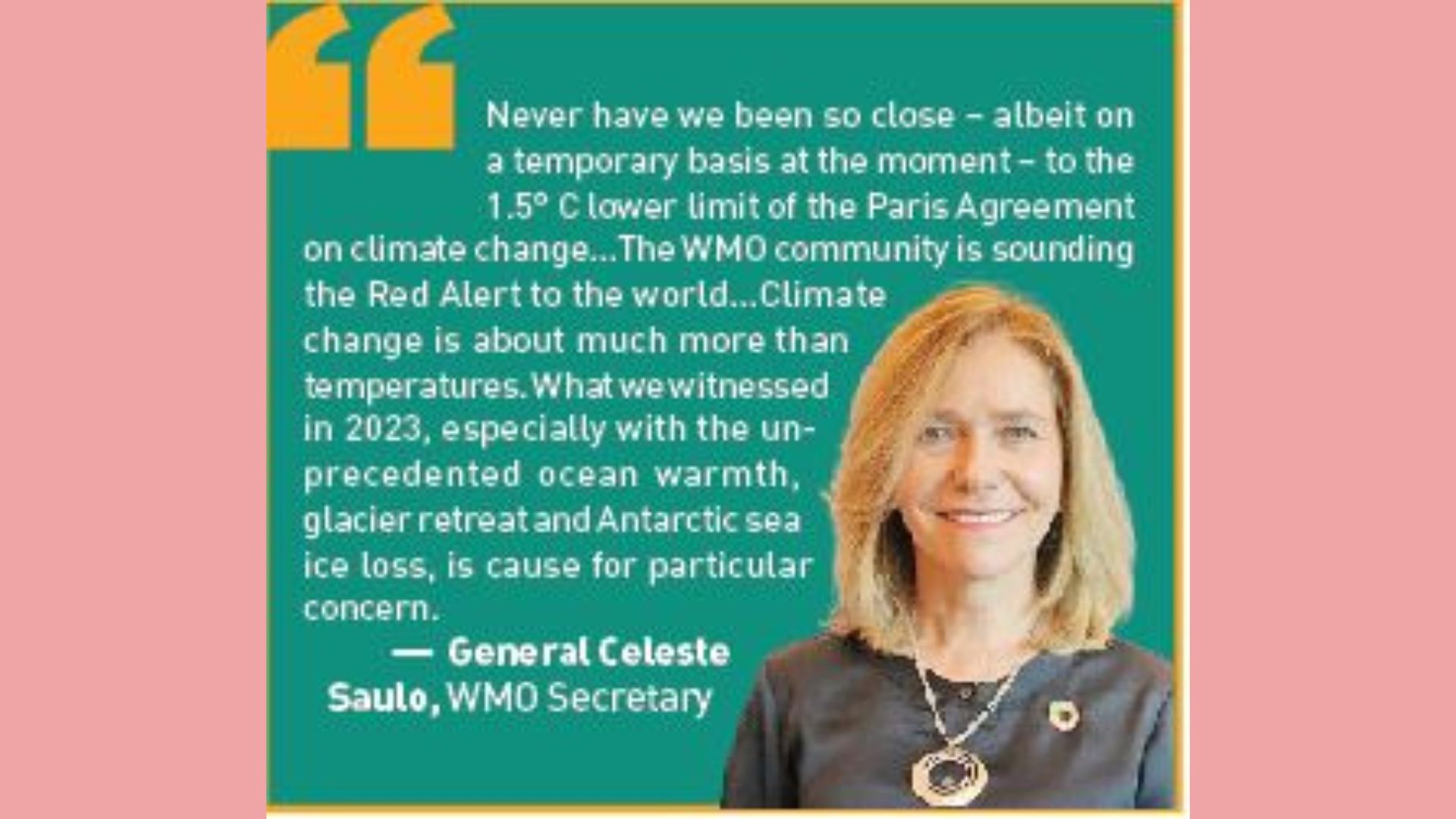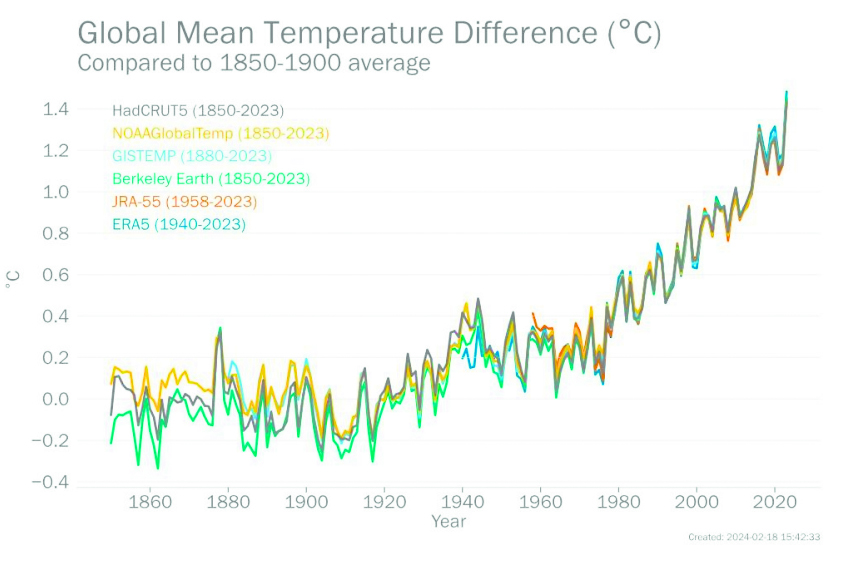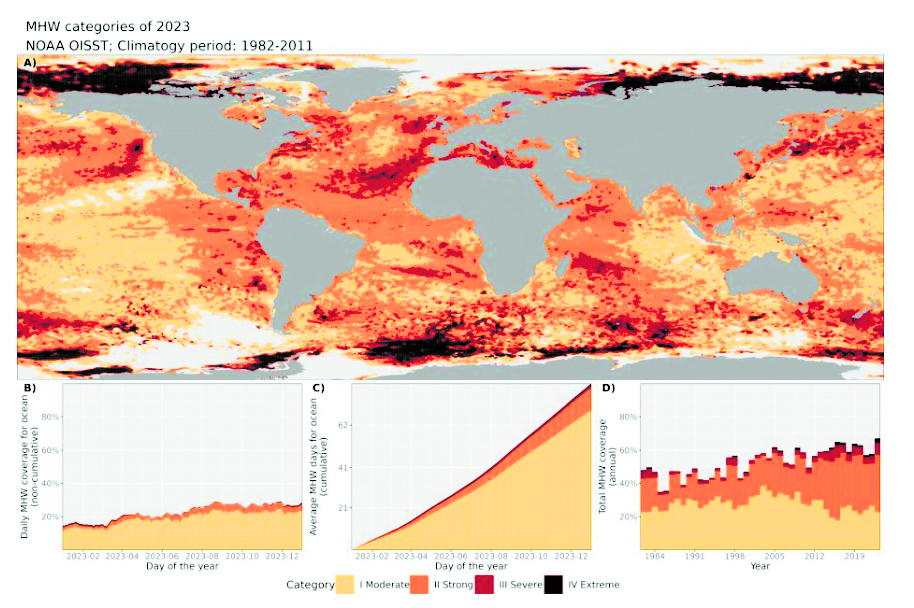
The latest report from the World Meteorological Organization (WMO) reveals that records were once again surpassed across various climate indicators, including greenhouse gas levels, surface temperatures, ocean heat and acidification, sea level rise, Antarctic sea ice cover, and glacier retreat.
The year 2023 witnessed extreme weather events such as heatwaves, floods, droughts, wildfires, and intensifying tropical cyclones, resulting in significant disruptions to daily life for millions and causing extensive economic losses, as outlined in the WMO State of the Global Climate 2023 report.
The report confirms that 2023 set a new record as the warmest year on record, with the global average near-surface temperature surpassing 1.45 °Celsius above the pre-industrial baseline (with a margin of uncertainty of ± 0.12 °C). Additionally, it marked the warmest ten-year period on record.
“Sirens are blaring across all major indicators… Some records aren’t just chart-topping, they’re chart-busting. And changes are speeding up,” said United Nations Secretary-General António Guterres.
“Never have we been so close – albeit on a temporary basis at the moment – to the 1.5° C lower limit of the Paris Agreement on climate change,” said WMO Secretary-General Celeste Saulo. “The WMO community is sounding the Red Alert to the world.”
“Climate change is about much more than temperatures. What we witnessed in 2023, especially with the unprecedented ocean warmth, glacier retreat and Antarctic sea ice loss, is cause for particular concern,” she said.
In 2023, nearly one-third of the global ocean experienced a marine heatwave on an average day, impacting crucial ecosystems and food systems. By the end of the year, over 90% of the ocean had encountered heatwave conditions at some point.
Preliminary data revealed that the global reference glaciers suffered their most significant ice loss on record since 1950, primarily due to extreme melt in western North America and Europe.
Furthermore, the Antarctic sea ice extent hit a historic low, with the maximum extent at the end of winter plummeting by 1 million km2 compared to the previous record year, equivalent to the size of France and Germany combined.
“The climate crisis is THE defining challenge that humanity faces and is closely intertwined with the inequality crisis – as witnessed by growing food insecurity and population displacement, and biodiversity loss” said Celeste Saulo.
The annual global mean temperature anomalies, relative to 1850–1900, have been tracked from 1850 to 2023 using data from six datasets.
According to the World Food Programme, the number of acutely food insecure people worldwide more than doubled from 149 million before the COVID-19 pandemic to 333 million in 2023 across 78 monitored countries. While weather and climate extremes may not be the root cause, they exacerbate the situation.
In 2023, weather hazards continued to induce displacement, highlighting how climate shocks erode resilience and introduce new protection challenges among vulnerable populations.
Despite these challenges, there’s a glimpse of optimism. Renewable energy generation, primarily fueled by solar radiation, wind, and the water cycle, has emerged as a pivotal tool in climate action because of its potential to achieve decarbonization goals. In 2023, renewable capacity additions surged by almost 50% compared to 2022, reaching a total of 510 gigawatts (GW) – marking the highest observed rate in the past two decades.
This week, the Copenhagen Climate Ministerial on 21-22 March will bring together climate leaders and ministers worldwide for the first time since COP28 in Dubai, aiming to accelerate climate action. A key focus will be enhancing countries’ Nationally Determined Contributions (NDCs) before the February 2025 deadline. Additionally, securing an ambitious agreement on financing at COP29 to translate national plans into action will be a top priority.
“Climate Action is currently being hampered by a lack of capacity to deliver and use climate services to inform national mitigation and adaptation plans, especially in developing countries. We need to increase support for National Meteorological and Hydrological Services to be able to provide information services to ensure the next generation of Nationally Determined Contributions are based on science”, said Celeste Saulo.
The State of the Global Climate report, released ahead of World Meteorological Day on 23 March, serves as a precursor to a new climate action campaign by the UN Development Programme and WMO, set to launch on 21 March.





POINTS TO BE NOTED:
GREENHOUSE GASES TOUCH EXCEPTIONAL HIGHTS: In 2022, observed concentrations of the three primary greenhouse gases—carbon dioxide, methane, and nitrous oxide—reached unprecedented levels. Real-time data from various locations indicate a continued rise in these concentrations throughout 2023.
Carbon dioxide (CO2) levels, specifically, are now 50% higher than those seen in the pre-industrial era. This increase has led to the trapping of heat in the atmosphere. Given the long lifespan of CO2, temperatures are expected to continue rising for many years into the future.
TEMPERATURE SOARED TO 1.45 ± 0.12 °C: In 2023, the global mean near-surface temperature soared to 1.45 ± 0.12 °C above the pre-industrial average of 1850–1900. This marked the highest temperature recorded in the 174-year observational history, surpassing the previous records set in 2016 (1.29 ± 0.12 °C) and 2020 (1.27±0.13 °C).
Furthermore, the ten-year average temperature spanning from 2014 to 2023 stands at 1.20±0.12°C above the 1850–1900 average, underscoring the sustained trend of warming temperatures over the past decade.
OCEAN HEAT AT ITS PEAK: In 2023, ocean heat content surged to its peak level, as revealed by a comprehensive analysis of data. The warming trend has notably accelerated over the past two decades, indicating a concerning trajectory.
Projections indicate that this warming trend will persist, with consequences that are irreversible over extended periods ranging from hundreds to thousands of years. The prevalence of more frequent and severe marine heat waves poses significant threats to marine ecosystems and coral reefs, exacerbating existing challenges.
RISE IN SEA LEVEL: In 2023, the global mean sea level attained an unprecedented high in the satellite record, which extends back to 1993. This alarming increase reflects ongoing ocean warming, primarily due to thermal expansion, as well as the melting of glaciers and ice sheets.
Comparing the past decade (2014–2023) to the initial decade of satellite observations (1993–2002), the rate of global mean sea level rise has more than doubled. This acceleration underscores the urgency of addressing climate change and its impacts on our planet’s oceans.
ANTARCTICA MELTING: In February 2023, the Antarctic sea-ice extent plummeted to an all-time low for the satellite era, which began in 1979. Remarkably, this record low persisted from June until early November of the same year. During September, typically the month of maximum ice coverage, the extent reached 16.96 million km2. This figure is approximately 1.5 million km2 below the average for the period from 1991 to 2020 and 1 million km2 lower than the previous record low maximum.
SOCIO-ECONOMIC IMPACTS: Weather and climate hazards exacerbated existing challenges related to food security, population displacement, and impacts on vulnerable populations. These hazards continued to trigger new, prolonged, and secondary displacement, further increasing the vulnerability of those already affected by complex situations of conflict and violence.